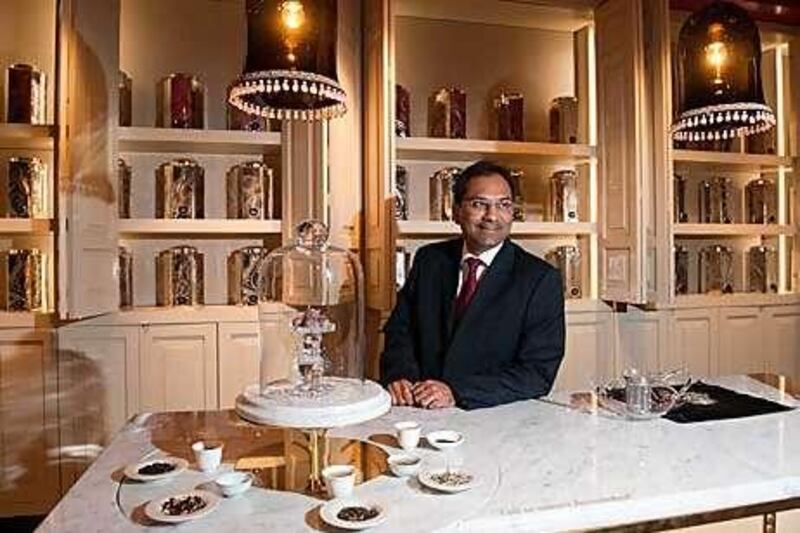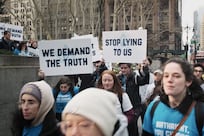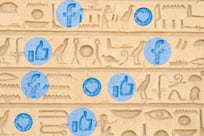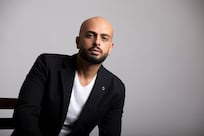Nothing remains of the grand neo-classical building on Leadenhall Street in the City of London in which once beat the heart of the nascent British empire and through whose Doric-porticoed entrance flowed much of the wealth of India for the best part of 150 years.
East India House, built in 1729 as an imposing monument to and headquarters for the Honourable East India Company, one of the world's first trans-global businesses, was demolished in 1869, a decade after the British government finally pulled the plug and pocketed the company's assets. Gone are the fine carvings and paintings, each of which celebrated some aspect of the company's achievements and power - its powerful fleet of East Indiamen, its depots and forts around which grew such great cities as Mumbai and Chennai.
Gone too is the ceiling fresco that once adorned the Revenue Committee Room and the title of which has an uncomfortable resonance in the modern era: "The East Offering its Riches to Britain." But just a few miles away in Conduit Street, Mayfair, the original coat of arms of the East India Company, granted by Elizabeth I in 1600, has been raised again and the company name, lost in limbo for a century and a half, has been dusted off and brought back to life.
Founded four centuries ago by a group of English commercial adventurers, many of whom set a precedent for generations of successors by leaving their bones on foreign soil, "John Company" grew to become a powerful state within a state - a vast enterprise with its own government, navy and army, deploying force in the best interests of its shareholders and reigning over its own kingdom: India. In 1858, it was dissolved by the British government in the wake of the disastrous Indian Mutiny, better known in India as the First War of Independence. Now, 150 years later and 410 years after it was founded, the Honourable East India Company is back in business.
And, in a historical twist that quite possibly might have that most famous of East Indiamen, Robert Clive, spinning in his Shropshire grave, the man with his hand on the helm in 2010 is an Indian. The East is offering its riches to Britain once again, but this time on altogether more equal terms. Post-empire, and even within its lifetime, "Honourable" was not a word many have chosen to describe the activities of the East India Company. The British MP and social philosopher Edmund Burke, the focus of parliamentary disquiet at the activities of the Company, remarked in 1783 that "every rupee of profit made by an Englishman is lost forever to India". Three years later, he led the unsuccessful impeachment of Warren Hastings, the Company's former governor-general of Bengal, whom he described as the "captain-general of iniquity", a "ravenous vulture devouring the carcasses of the dead".
The Company's reputation hardly improved with the passage of time. In 2003, Nick Robbins, then head of socially responsible investment research for a firm in the City of London, writing for Open Democracy, declared that for Indians "it was the Company's plunder that first de-industrialised their country and then provided the finance that fuelled Britain's own industrial revolution. In essence, the Honourable East India Company found India rich and left it poor."
Clive, certainly, was among those who returned home to England a great deal better off than when they had arrived. He started out as a company clerk but soon discovered that, in some cases, the sword was mightier than the pen. Assuming command of the firm's troops, he defeated the last independent Moghal nawab of Bengal at the Battle of Plassey in 1757 - a victory widely regarded as the foundation stone of the British Empire - and helped himself to enough of the nawab's immense wealth to become one of the richest men in England.
Back home, at first he was awarded a baronetcy by a grateful nation. Years later, when he was accused (and then cleared) of plundering, he remarked: "An opulent city lay at my mercy. Vaults were thrown open to me alone, piled on either hand with gold and jewels. At this moment, I stand astonished at my own moderation." But despite such history, Sanjiv Mehta, a businessman from Mumbai - which, as Bombay, was the headquarters of the Company in India from 1687 - takes a benign view of the activities of the business he has inherited and whose fortunes he hopes to revive.
He is, of course, trying to sell up-market tea and biscuits on the strength of the company's name, but he flatly rejects the suggestion that the East India Company was little more than an evil empire sucking the goodness out of India. "No, I don't think that's the case," he says. "That's a very political view and it's a very easy statement to make." It is, he concedes, a nice historical irony that an Indian has been able to buy the company, but that does not alter the nature of its legacy for India.
When the English turned up, he says, India was a collection of warring princely states. Without the Company, "Today, India is a country that would probably not exist. "I am talking to you because of the East India Company - the Company brought the English language," he says. "India plays cricket because of the Company, India has its bureaucracy, civil system, mercantile law, sports, bridges, its railway system, postal system, because of the East India Company. Why is India able to compete with China in IT? Because Indians speak English."
Mr Mehta has certainly done his homework. He bought the brand in 2005, from a group of businessmen who had acquired it from the British Treasury in the 1990s but had developed only a modest business importing tea and coffee. Since then, he has been mapping out his grand plan and getting to know what is, he says, the world's original luxury brand - and one so endurable that it has emerged from its 150-year slumber with a ready-made profile any business would kill for. As it were.
"Over two billion people in the world recognise the name instantly," he says. Even better, "the words people associate with this name are adventure, journey, discover, explore, British, regal... I could spend millions of dollars and still not achieve that kind of brand." It took Mr Mehta two years "to understand the history, travelling around the world where the East India Company had operated, learning about the men who had built the business, the products they had traded in and the routes and the countries they traded with, and the influence that had across the world in language, sport, culture and art.
"Everything we do is based on the philosophy of the pioneering spirit of the East India Company." Then he asked himself an intriguing question: "If the East India Company had not ceased trading and the management had decided to build a luxury brand, what would it be?" Part of the answer can be found in the company's new flagship shop, along with its Elizabethan coat of arms, on Conduit Street. It was opened, with suitable historical resonance, on August 15, Indian independence day, and it stocks company-branded versions of many of the products the company introduced to the western world.
The list is long - and delicious. It includes teas, coffees, biscuits, chocolates, jams, marmalades, mustards, honey, cordials and sweets. Next up will be chutneys, pickles and sauces from India, sweets and dried fruits from the Middle East, sushi from Japan and similar products from China. "That was the East India Company's pattern," Mr Mehta says, "to bring what is ordinary in one part of the world and take it to another part where it becomes exotic. The East India Company controlled the waters of the world and the fastest possible way to achieve supremacy of global trade. In the process they created wealth, but also spread culture."
Mr Mehta's ambition is not limited to nice nibbles and he has ambitious plans for expansion, both territorially and in terms of market sectors. Such a well-known brand, he believes, could be the basis for many up-market enterprises, from leather goods, fashion and jewellery to hotels and travel. Such dreams do not come cheap, of course, which is why he will be coming to Dubai and Abu Dhabi in the near future. "We are talking to a few large luxury partners in the GCC region and we believe that the brand and our positioning are very suitable for the Middle East market, as well as Japan, Russia and China. And, of course, it is natural to be in some way in India."
The history of the company, he says, is the history of much of this part of the world, and he would like to see museums as well as shops take root in the rich soil of the brand's past. The East India Company certainly played a major role in the development of what were the Trucial States, concerned as it was with keeping open its vital trade routes from India and beyond to Basra at the head of the Gulf - though perhaps it might be better, for now, to skate over the details of the commercially motivated sack of Ras al Khaimah by Company men and ships in 1809 and 1819.
On the other hand, these events led directly to the Treaty of 1820 with Britain, the formation of the Trucial States and, indirectly, to the unification of the seven emirates in 1971. In some ways, Mr Mehta has much in common with the young Englishmen who followed their dreams across the seas. A gemologist by training, born and educated in Mumbai, he had been working in the family diamonds and jewellery business for seven years when, at 26, "I realised that I wanted to migrate and live in a place that allowed me to further my dreams". Now 49, he has spent the past 20 years in London, where he lives with his wife and their son and daughter, aged 21 and 18.
What would Clive think? Mr Mehta laughs and says he neither knows nor cares. "I believe in living in the present and building my future rather than walking down the alleys of the past. Life is not about yesterday. You can be inspired by it, you cull from that, but you need to walk forward." But all his pragmatism cannot disguise his respect for the history he has inherited. The men of the East India Company, he says, "were passionate, they were pioneering, and they were very patient, to build a commercial enterprise that lasted so many years".
He has, he says, only "taken custody of an important piece of history. It is not a brand that belongs to England or to India, it belongs to the world. It doesn't belong to an age, or a generation, or a culture. "As the custodian, I have to have the wisdom not to destroy the name and, if I can, to add a bit to it for the future. That is the job in front of me for the coming years." In 2003, Robbins wrote: "In a country like Britain, that is so drenched in the culture of heritage, the public invisibility of the East India Company is suspicious." He put that down to a kind of post-colonial guilt associated with one of the many words Britain inherited from Hindi: "loot".
Perhaps now, with its rehabilitation under new, Indian, management, the East India Company can begin to be associated with something less distasteful. Such as very nice biscuits, for example. @Email:jgornall@thenational.ae
? It was the East India Company's tea that ended up in Boston Harbour in 1773, an event that was one of the landmarks on the road to the American Revolution. ? The East India Company's flag consisted of the Union Jack in the canton and 13 red-and-white stripes, a design that, notwithstanding the above, is believed to have influenced the design of the United States flag. ? The East India Company gave the English language the expression "civil servants", which it used to distinguish its bureaucrats and traders from its "military servants", or private armies.






